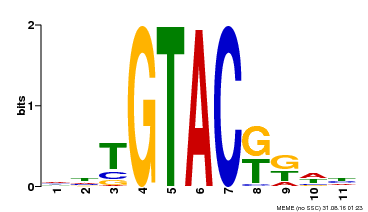- Cardon G, et al.
Molecular characterisation of the Arabidopsis SBP-box genes.
Gene, 1999. 237(1): p. 91-104
[PMID:10524240] - Riechmann JL, et al.
Arabidopsis transcription factors: genome-wide comparative analysis among eukaryotes.
Science, 2000. 290(5499): p. 2105-10
[PMID:11118137] - Rhoades MW, et al.
Prediction of plant microRNA targets.
Cell, 2002. 110(4): p. 513-20
[PMID:12202040] - Schmid M, et al.
Dissection of floral induction pathways using global expression analysis.
Development, 2003. 130(24): p. 6001-12
[PMID:14573523] - Yamada K, et al.
Empirical analysis of transcriptional activity in the Arabidopsis genome.
Science, 2003. 302(5646): p. 842-6
[PMID:14593172] - Yamasaki K, et al.
A novel zinc-binding motif revealed by solution structures of DNA-binding domains of Arabidopsis SBP-family transcription factors.
J. Mol. Biol., 2004. 337(1): p. 49-63
[PMID:15001351] - Gong W, et al.
Genome-wide ORFeome cloning and analysis of Arabidopsis transcription factor genes.
Plant Physiol., 2004. 135(2): p. 773-82
[PMID:15208423] - Yoo BC, et al.
A systemic small RNA signaling system in plants.
Plant Cell, 2004. 16(8): p. 1979-2000
[PMID:15258266] - Scheible WR, et al.
Genome-wide reprogramming of primary and secondary metabolism, protein synthesis, cellular growth processes, and the regulatory infrastructure of Arabidopsis in response to nitrogen.
Plant Physiol., 2004. 136(1): p. 2483-99
[PMID:15375205] - Birkenbihl RP,Jach G,Saedler H,Huijser P
Functional dissection of the plant-specific SBP-domain: overlap of the DNA-binding and nuclear localization domains.
J. Mol. Biol., 2005. 352(3): p. 585-96
[PMID:16095614] - Duarte JM, et al.
Expression pattern shifts following duplication indicative of subfunctionalization and neofunctionalization in regulatory genes of Arabidopsis.
Mol. Biol. Evol., 2006. 23(2): p. 469-78
[PMID:16280546] - Schwarz S,Grande AV,Bujdoso N,Saedler H,Huijser P
The microRNA regulated SBP-box genes SPL9 and SPL15 control shoot maturation in Arabidopsis.
Plant Mol. Biol., 2008. 67(1-2): p. 183-95
[PMID:18278578] - Wang JW,Schwab R,Czech B,Mica E,Weigel D
Dual effects of miR156-targeted SPL genes and CYP78A5/KLUH on plastochron length and organ size in Arabidopsis thaliana.
Plant Cell, 2008. 20(5): p. 1231-43
[PMID:18492871] - Ascencio-Ib
Global analysis of Arabidopsis gene expression uncovers a complex array of changes impacting pathogen response and cell cycle during geminivirus infection.
Plant Physiol., 2008. 148(1): p. 436-54
[PMID:18650403] - Wu G, et al.
The sequential action of miR156 and miR172 regulates developmental timing in Arabidopsis.
Cell, 2009. 138(4): p. 750-9
[PMID:19703400] - Yu N, et al.
Temporal control of trichome distribution by microRNA156-targeted SPL genes in Arabidopsis thaliana.
Plant Cell, 2010. 22(7): p. 2322-35
[PMID:20622149] - Chen X, et al.
SQUAMOSA promoter-binding protein-like transcription factors: star players for plant growth and development.
J Integr Plant Biol, 2010. 52(11): p. 946-51
[PMID:20977652] - Xing S,Salinas M,H
miR156-targeted and nontargeted SBP-box transcription factors act in concert to secure male fertility in Arabidopsis.
Plant Cell, 2010. 22(12): p. 3935-50
[PMID:21177480] - Gou JY,Felippes FF,Liu CJ,Weigel D,Wang JW
Negative regulation of anthocyanin biosynthesis in Arabidopsis by a miR156-targeted SPL transcription factor.
Plant Cell, 2011. 23(4): p. 1512-22
[PMID:21487097] - Li S,Yang X,Wu F,He Y
HYL1 controls the miR156-mediated juvenile phase of vegetative growth.
J. Exp. Bot., 2012. 63(7): p. 2787-98
[PMID:22268150] - Yu S, et al.
Gibberellin regulates the Arabidopsis floral transition through miR156-targeted SQUAMOSA promoter binding-like transcription factors.
Plant Cell, 2012. 24(8): p. 3320-32
[PMID:22942378] - Stief A, et al.
Arabidopsis miR156 Regulates Tolerance to Recurring Environmental Stress through SPL Transcription Factors.
Plant Cell, 2014. 26(4): p. 1792-1807
[PMID:24769482] - Cui LG,Shan JX,Shi M,Gao JP,Lin HX
The miR156-SPL9-DFR pathway coordinates the relationship between development and abiotic stress tolerance in plants.
Plant J., 2014. 80(6): p. 1108-17
[PMID:25345491] - Yu ZX, et al.
Progressive Regulation of Sesquiterpene Biosynthesis in Arabidopsis and Patchouli (Pogostemon cablin) by the miR156-Targeted SPL Transcription Factors.
Mol Plant, 2015.
[PMID:25355059] - Jin J, et al.
An Arabidopsis Transcriptional Regulatory Map Reveals Distinct Functional and Evolutionary Features of Novel Transcription Factors.
Mol. Biol. Evol., 2015. 32(7): p. 1767-73
[PMID:25750178] - Yu N,Niu QW,Ng KH,Chua NH
The role of miR156/SPLs modules in Arabidopsis lateral root development.
Plant J., 2015. 83(4): p. 673-85
[PMID:26096676] - Morea EG, et al.
Functional and evolutionary analyses of the miR156 and miR529 families in land plants.
BMC Plant Biol., 2016. 16: p. 40
[PMID:26841873] - Hyun Y, et al.
Multi-layered Regulation of SPL15 and Cooperation with SOC1 Integrate Endogenous Flowering Pathways at the Arabidopsis Shoot Meristem.
Dev. Cell, 2016. 37(3): p. 254-66
[PMID:27134142] - Xu M, et al.
Developmental Functions of miR156-Regulated SQUAMOSA PROMOTER BINDING PROTEIN-LIKE (SPL) Genes in Arabidopsis thaliana.
PLoS Genet., 2016. 12(8): p. e1006263
[PMID:27541584] - Mahmood K,Xu Z,El-Kereamy A,Casaretto JA,Rothstein SJ
The Arabidopsis Transcription Factor ANAC032 Represses Anthocyanin Biosynthesis in Response to High Sucrose and Oxidative and Abiotic Stresses.
Front Plant Sci, 2016. 7: p. 1548
[PMID:27790239] - Mao YB, et al.
Jasmonate response decay and defense metabolite accumulation contributes to age-regulated dynamics of plant insect resistance.
Nat Commun, 2017. 8: p. 13925
[PMID:28067238] - Nguyen ST,Greaves T,McCurdy DW
Heteroblastic Development of Transfer Cells Is Controlled by the microRNA miR156/SPL Module.
Plant Physiol., 2017. 173(3): p. 1676-1691
[PMID:28082719] - Duan HC, et al.
ALKBH10B Is an RNA N6-Methyladenosine Demethylase Affecting Arabidopsis Floral Transition.
Plant Cell, 2017. 29(12): p. 2995-3011
[PMID:29180595] - Dotto M,Gómez MS,Soto MS,Casati P
UV-B radiation delays flowering time through changes in the PRC2 complex activity and miR156 levels in Arabidopsis thaliana.
Plant Cell Environ., 2018. 41(6): p. 1394-1406
[PMID:29447428] - He J, et al.
Threshold-dependent repression of SPL gene expression by miR156/miR157 controls vegetative phase change in Arabidopsis thaliana.
PLoS Genet., 2018. 14(4): p. e1007337
[PMID:29672610]
|





